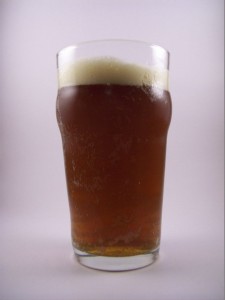Or: taste-testing the quality of your Pilsen. The kölsch is a base malt showcase. Ours used 8# 10 oz of pilsner malt, 7 oz of Vienna, and that’s it. An ounce and a half of Hallertauer at 60 minutes was the only hop addition. WLP029 yeast and water round out the Reinheitsgebot-y recipe. We used a longer cool mash on this one – 90 minutes at 149F. Both the ingredients and the process are reminiscent of making a light lager. A 90 minute boil was a given considering the grain bill. The post boil gravity came in at exactly what we planned, 1.048, which is always a pleasant surprise. The finished gravity of 1.009 was also squarely in line with style.
A glassful certainly looks like a light lager. I’m really pleased with the clarity; you can see right through the glass. There’s not a whole lot of flavor to speak of yet there’s enough body to it that it’s not watery. I suppose that’s what the guidelines term delicate. It’s not sweet, or caramel, or bready, or roasty. I’d like to think that mild flavor I can’t quite place is simply malt. The finish is clean and dry enough that I could keep sipping this for hours. Like many lagers this isn’t something I would pick out at the bar or store, but as homebrew I think I like it more in terms of what it represents. It tastes like solid technique – neverminding the fact that isn’t a flavor at all.


